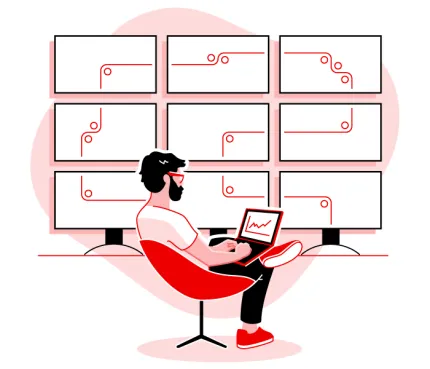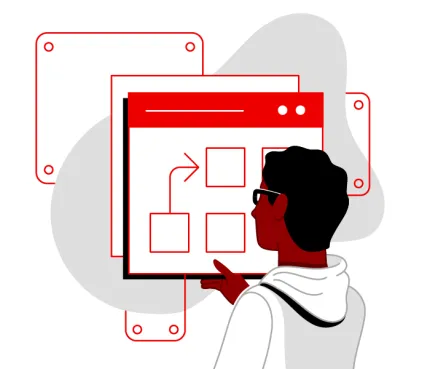In this post:
One of the best things organizations can do to transform their operations is also one of the things they're often hesitant to do: really embrace automation. Most organizations have some automation in their environment, but to really be effective it's time to automate all the things.
The first challenge of automation: Trust
The first big challenge for automation is trust. Not in the sense of "do I trust people I work with," but trusting what we're doing with automation.
Until you get started with the process of automation, there will be people who have doubts about automation. How do we know what's being done, who's doing it, where it's happening?
Most importantly, what happens if something goes wrong? Those are valid questions, but notice that we don't ask the same questions about processes that are being performed manually and therefore are prone to mistakes every time a task is performed.
Automation allows us to refine and improve how things are done, one-off tasks are new opportunities for mistakes each time they're performed. But because we've "always" done it that way, people are more comfortable.
So the biggest challenge isn't technical -- even though automation is heavily technical -- it's the people element. It's establishing trust in what you're doing and getting started so that you can meet your objectives.
 Quality everywhere, automation everywhere
Quality everywhere, automation everywhere
We've gotten used to the idea that we can apply testing and validation to software development and releases. Companies have already poured a lot of resources into CI/CD and testing to decide whether something is ready to release. Now we just have to expand that to the larger IT environment.
Other industries have already gone through this type of transformation in other ways. Cars, appliances, any type of manufacturing really, have been heavily standardized and automated.
In the last 10 or 15 years, that transition of IT has become more important, as computing has become more important. Because everything that we do has become more connected we have to change our expectations around how something should be delivered.
And as soon as one area or one group improves a process, the next group wants the next steps to be better as well. It's back to those same parallels in software automation. It's about how we can keep gaining those efficiencies, gain more advantages or benefits from what we're doing.
Automation from hybrid cloud to the edge
Companies are also looking to hybrid cloud to transform their IT, but you can't really talk about cloud without automation. The two are heavily connected.
Some may, cynically, say that cloud is really just managed data centers where you've outsourced hardware and provisioning. But they're ignoring or overlooking the value of cloud computing -- the ability to work with a common platform and truly leverage Infrastructure as Code (IaC). The ability to automate all of those things we used to do on our own premises by hand, or file tickets with managed services to do.
Without automation, you lose the advantages of cloud computing at any real scale. And as we look to the near future of computing and the importance of edge computing, automation becomes even more important.
While we're still sorting out what "edge computing" means -- you ask 10 people what it is now, you'll get 11 answers -- having the ability to manage edge and Internet of Things (IoT) devices that number in the hundreds or thousands (or more) doesn’t just require automation, it necessitates it.. We can't make use of all the functionality that cloud and edge computing give us without adopting and embracing new capabilities to manage them.
To take full advantage of these new capabilities, we need consistency in the operational platform, which is why we’re starting to see technologies like Kubernetes extend to the edge. But we still need to automate the last mile for the specifics of what you do.
Whether Cloud or Edge, consistency is key. We need to provide consistency of platforms, via tooling and capability across those locations so that the people deploying applications, using those devices and connected machines in those places can make what they need to make happen and not be dependent on trying to figure out also how to deploy it, how to manage it, how to configure it?
We've automated all the things, now what?
What does an automated future look like? Who's involved and what benefits are we going to see?
A common mistake when organizations embark on their automation journey is to think that automation only benefits the people doing the automation. And while it does, it only becomes truly powerful when you offer your automation to other teams.
Think about why the clouds have been so successful in what they were able to offer. Offer the service, offer it well. Make the act of consuming as, or more important than the act of providing.
To really extend automation, to empower and automate across an organization, you need to facilitate the people to automate, providing what they want, where they need without unnecessary hindrance. As you start that move from the individual, out to teams, and then the wider organization, that's who has to be involved.
Therefore, the easy answer to "who should be involved?" is "anybody who wants to be or needs to be involved."
That’s where you sta

rt to see the bigger benefits, automating more of the end-to-end, more of the connections between groups that were previously disconnected. Those steps that are currently challenging become more cost-effective or justified. And in turn, the benefit of doing so is more obvious because surrounding steps are also done. The results are more tangible.
Whether you’re looking to improve the efficiency of delivery time. React and respond to situations that aren't just "lights on" or fire drills. Being able to react and respond to business needs, providing capabilities quicker. Or just look to reduce risk and reduce costly mistakes that may be made because people sometimes just make mistakes.
Automation becomes an enabler and part of what’s expected, rather than a nice to have. You can be proactive about your automation and what you automate, rather than reactive to your lack of automation.
The automated future is automating "all the things" that can, could or should be automated so that the people in the equation can do the more valuable activities required for your business success.
 Quality everywhere, automation everywhere
Quality everywhere, automation everywhere rt to see the bigger benefits, automating more of the end-to-end, more of the connections between groups that were previously disconnected. Those steps that are currently challenging become more cost-effective or justified. And in turn, the benefit of doing so is more obvious because surrounding steps are also done. The results are more tangible.
rt to see the bigger benefits, automating more of the end-to-end, more of the connections between groups that were previously disconnected. Those steps that are currently challenging become more cost-effective or justified. And in turn, the benefit of doing so is more obvious because surrounding steps are also done. The results are more tangible.
